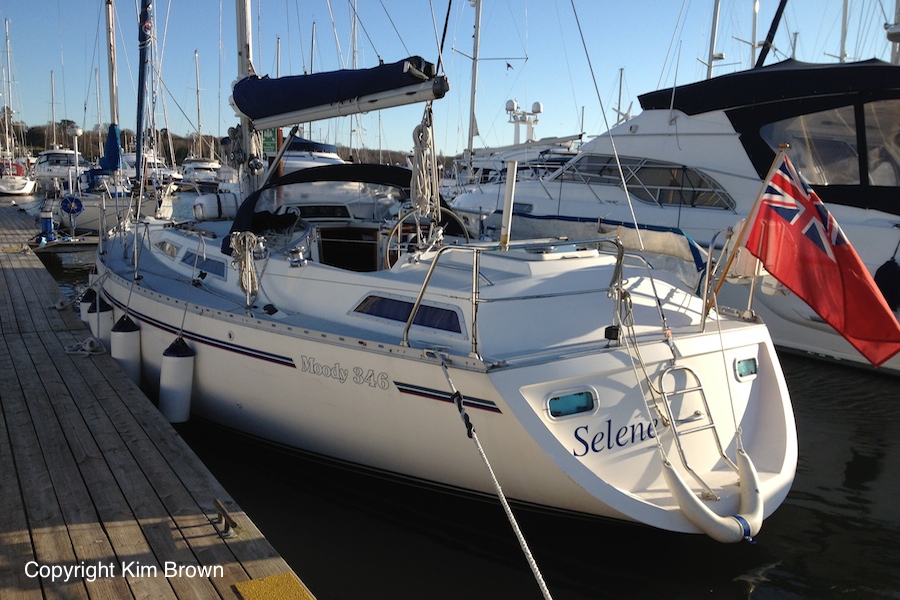 Back in England, when we had our 35’ Moody sailboat (pictured above), I never considered using the anchor. In fact, I never looked at it nor did I know the location of the windless (anchor) controls. I didn’t even want to know how to anchor a sailboat.
Back in England, when we had our 35’ Moody sailboat (pictured above), I never considered using the anchor. In fact, I never looked at it nor did I know the location of the windless (anchor) controls. I didn’t even want to know how to anchor a sailboat.
When our engine cut out in the middle of Portsmouth Harbor – one the busiest harbors in the world – not once did it dawn on me to drop our anchor. It wasn’t even in my mind as an option and looking back, it should have been. (Read Experiencing engine failure and living to tell the tale)
What’s wrong with using an anchor?
Well…you don’t know what you don’t know. And I just didn’t know how to anchor a sailboat. When we purchased our first boat, Selene (pictured above), we’d take her out for a 3 – 5-hour sail and head to another marina. Over the course of two years, we spent time in 5 other marinas – never considering finding a quiet bay or an inlet to drop a hook.
Looking back, we could have anchored in a bay for lunch but the old, mostly land-based Kim, always wanted to get to the final destination. Perhaps I was nervous about tying off and I just wanted to get it over with? Or maybe it was due to my reoccurring issues with seasickness? Or – could it have been the glass of wine that I was anticipating after what felt like a long sail?
At least the new, totally sea-based Kim, is now happy to sail for the sake of sailing.
Upon the mention of anchoring overnight, however, I’d shiver and say, ‘There’s no way I’d be able to sleep while anchored! What happens if it comes unearthed?’ I honestly couldn’t understand how anyone could get a good night’s sleep when open sea or worse, rocks and land could gobble up the boat.
Fast-forward to our new boat and our new life.
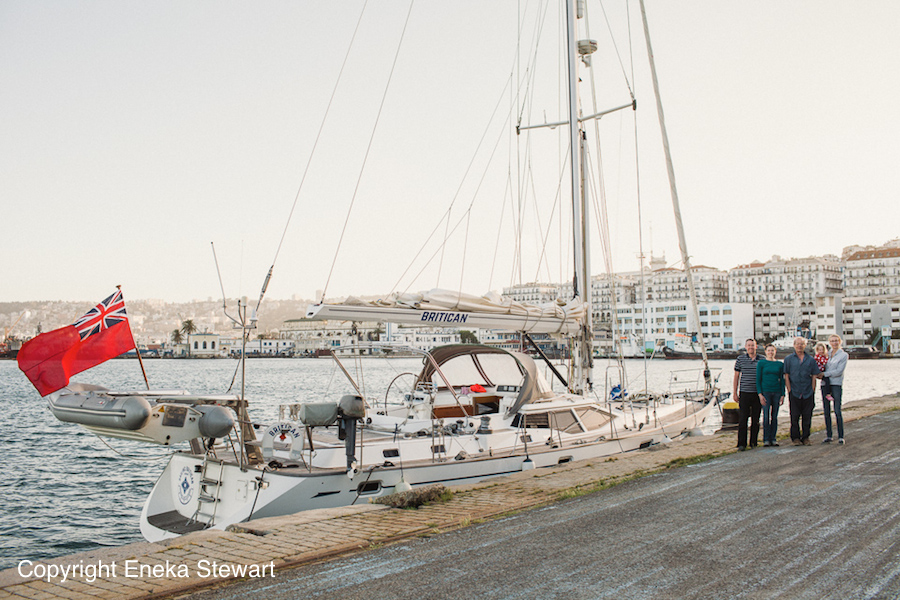
When we first started on our around the world adventure aboard 56′ Britcan (pictured above) in April 2014, we went from Marina to Marina. In fact, up until the second month of our around-the-world sailing adventure I never even looked at our anchor.
There was so much to learn and from my perspective, I still couldn’t fathom the concept of anchoring.
There was one evening, however, very early in our trip when we first arrived in Malta that an anchor was needed. Even though we could see the slip we were destined to tie off to, the marina was closed and we had to anchor literally in the middle of the marina.
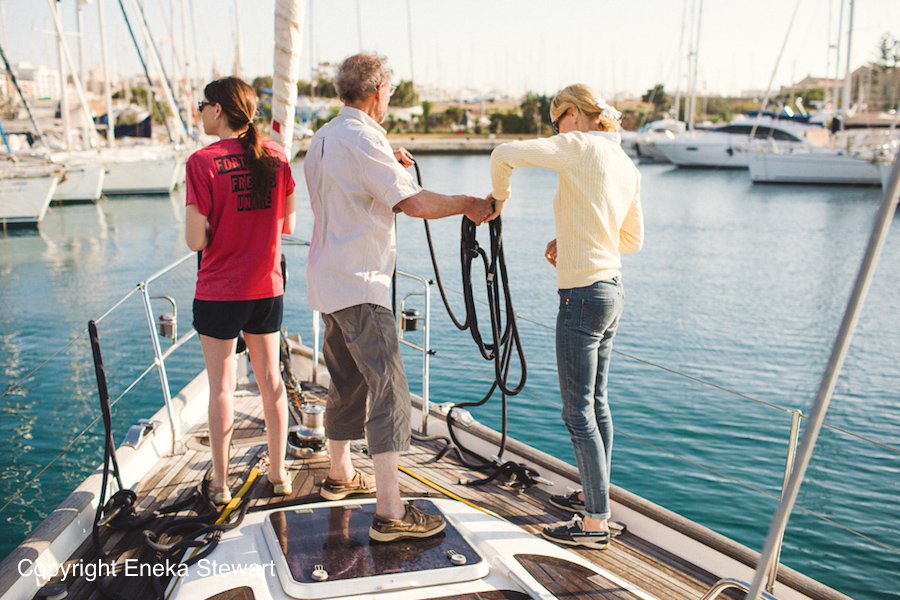
Imagine sailing over 850 nautical miles and having to anchor rather than tie off to land? Fortunately, we had a hired skipper (pictured above between my cousin and me) with us for our first trip and he set the anchor. Skipper Mike also tied a floating buoy to the top of the anchor so others would know where it was sitting. I thought, ‘wow – how professional’.
Looking around I questioned our spinning radius.
I looked at Skipper Mike and said, ‘But if the wind blows from a different direction, will we spin and hit something?’ I think I then asked several other questions and by the time I said, ‘But what if it doesn’t hold us,’ Skipper Mike barked out at me, “Kim – THE ANCHOR IS FINE. WE ARE FINE.’
His bellows seemed so convincing that I thought, ‘Okay, so I guess we’re going to be FINE.’ As you can imagine, I could see the jetty that we would soon be tied to. It was like putting candy in front of a kid and telling her that she couldn’t have it. Furthermore, we sailed over 850 miles – I wanted to get off.
Despite it being my first overnight anchoring experience on Britican, I slept very well.
But I didn’t sleep well because we were anchored and I felt secure in Skipper Mike’s decision. I slept well because I was exhausted. Fortunately, we survived the night, pulled up the anchor, and tied onto a jetty by 9 am the following morning. As you can see in the picture above, we didn’t have any anchor issues. Skipper Mike helped me pull up the anchor, tie lines to the bow, and hubby drove us into the slip that was next to us all night long.
After Malta, we went to Sicily. Fast-forward a few weeks in Sicily and we were fortunate to have an Italian Admiral sailing with us. Knowing the waters very well, the Admiral helped us, on how to anchor a sailboat, in a few spots.
My husband kept telling me that I’m going to have to get used to anchoring so I tried my best to go with the flow.
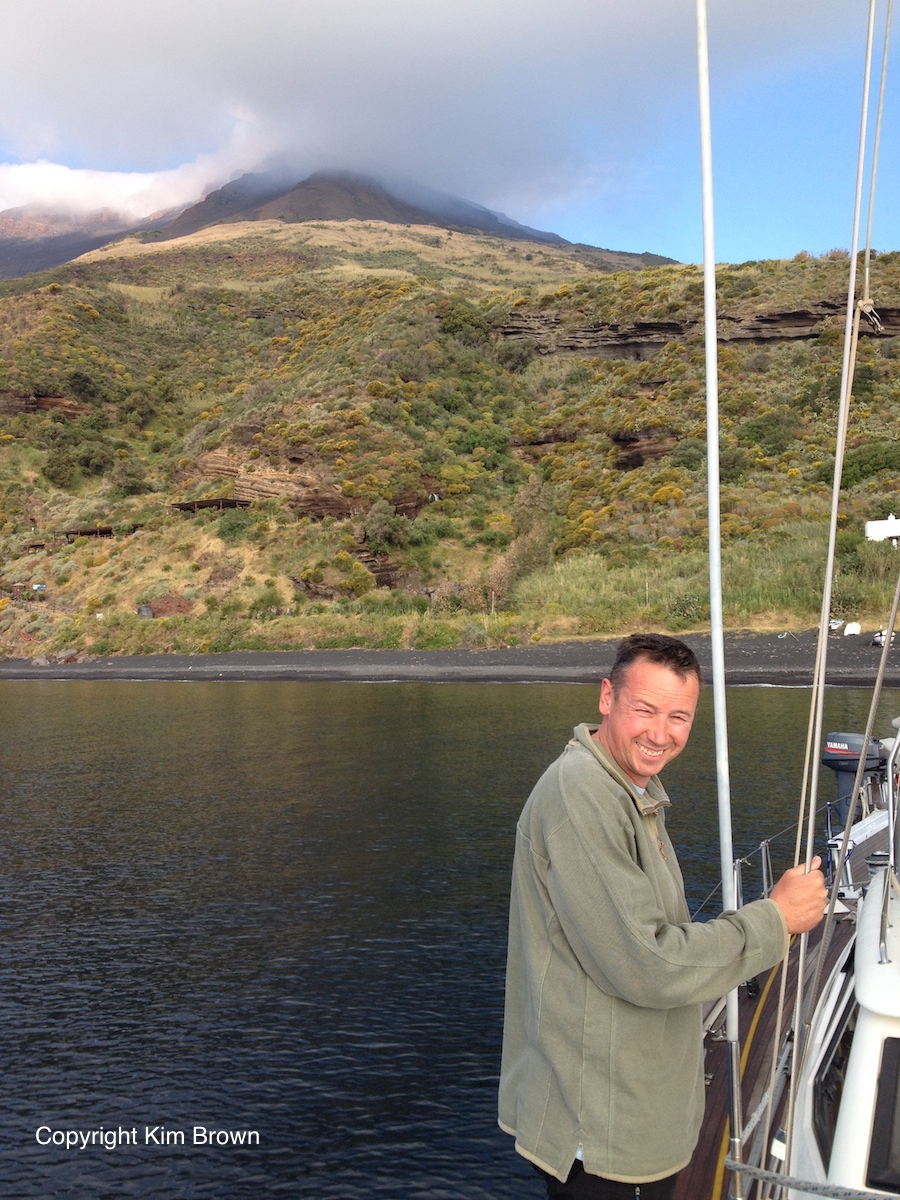
When I woke up and found us anchored 20 feet off of Stromboli Volcano I thought I’d die.
Fortunately for me and probably everyone else on the boat, I went to bed before we anchored, but that was after seeing lava spew 300 meters into the sky at 3 am. (Read Sailing around Stromboli Volcano needs to be on every sailors bucket list! ). Our stern was facing the island and I could have almost jumped from the back of the boat to land (see the above picture – includes my hubby). From all that I’ve read, I didn’t think you should ever anchor along a lee shore (shore facing the oncoming wind and waves).
Heck, if we even dragged a little our keel would surely hit bottom! That would not be how to anchor a sailboat!
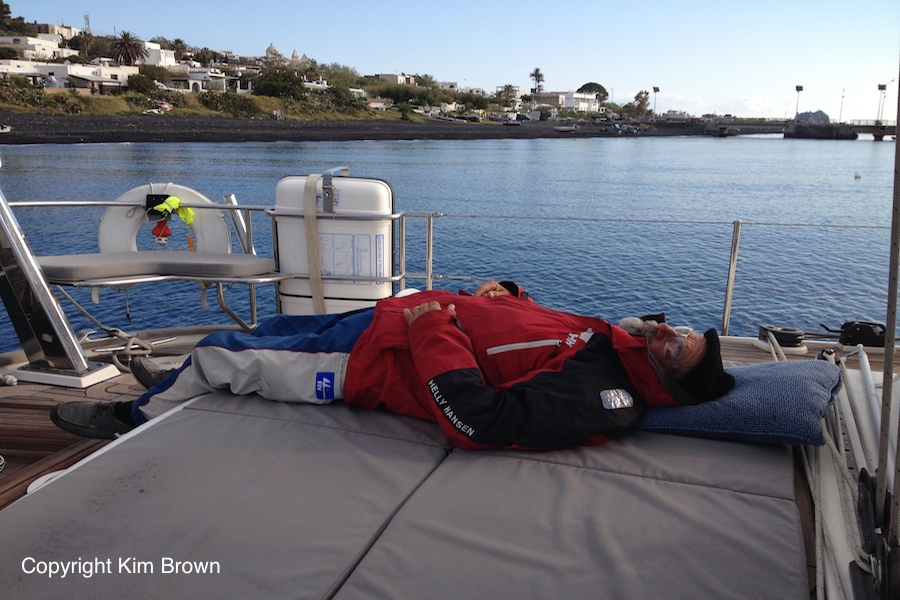
The admiral slept on the aft deck – he always sleeps outside (pictured above). Perhaps he also sleeps with one eye open?! Of course, I couldn’t question his decision to anchor on the lee shore – not only is he an admiral but he’s a local! I just thought in my head, ‘Simon better not try this kind of anchoring when I’m awake.’
In Sicily, I got a little more comfortable on how to anchor a sailboat.
Every ½ hour, I’d pop my head out and check our bearings. I kept telling myself, ‘Kim, you have got to get comfortable with anchoring. This is your life now.’
After Sicily, we sailed along the boot of Italy to the heel and then over to Corfu. Our first port of call was the little bay of Palaiokastrita, on the west side. We anchored in front of a hotel and between a rock and a cliff. There was ample room to swing and after several hours, I decided the boat wasn’t going to move. However, there was a surge and we rocked back and forth in the most uncomfortable way!
I didn’t sleep that night.
After anchoring a few more times, I started to relax a bit. And then I became cocky about things. I started calling myself the master anchor-woman and acted like I actually knew what I was doing. In my past, whenever I get cocky, I usually get pushed off my pedestal.
And here comes my disastrous anchoring story…

We, and 30 other boats, were anchored in the lovely bay of Lakka on the island Paxos, Greece – notice all the boats in the background pictured above. The picture is my daughter, Sienna, and my cousin, Loryn. We stayed for two days. On our first day, we anchored quite far out as we didn’t know the bay very well. By day two, we decided to lift our anchor and get closer to the town. The hope was that we’d be close enough to get some wifi from one of the bars.
And I have a sneaky suspicion that hubby wanted to show off our new boat.
Knowing now what I didn’t then, we should have never anchored so close to so many other boats. But then I wouldn’t be able to tell this story…
Due to the number of boats, we couldn’t let out very much chain. The best we could do was go into the wind, motor up to the very back of another boat, drop anchor and go back as far as we could considering that we have very little room to swing. We’re a 56’ boat – it’s just too big to get in amongst a bunch of other boats. We couldn’t let out enough chain to make our holding secure.
If the wind was steady everything would have been okay.
But that’s not what always happens when you’re at anchor. In fact, too little wind is bad, and too much wind is bad.
A little digression: Recently, while on a mooring buoy in no wind, I heard a “clank, clank.” I looked up and our davits (the things that hold our tender up at the back of the boat) were locked into the bow of a neighboring catamaran. Because there was no wind, we swung one way and they swung our way! Luckily, we knew our neighbors and I simply slept in the cockpit all night to push them off when needed. But I digress. Let me get back to the crowded bay.
So…we’re in a bay with people swimming off the back of their boats. Some boat decks are empty – either the occupants are down below sleeping or onshore enjoying lunch. My husband is just leaving me, my cousin and my daughter on board while he goes to take the trash ashore with the dinghy.
And out of nowhere, a 60 mph gust of wind hits all the boats.
We were broadside to the gust, so our boat took the full brunt of the wind. I could feel us tipping over and saw the strain on the anchor. Quickly, I yelled for Simon to get back to the boat, started the engine and before I took another breath I was running to the bow to fend off an unoccupied drifting boat.
I wouldn’t be exaggerating when I say that at least 75% of the boats dragged their anchor. It was like we’re all pieces on a chessboard that got blown to one corner.
After fending off one boat, I then had to detach our ladder from another boats anchor chain.
It was absolute chaos. At first, we didn’t want to admit that we might have dragged but we just didn’t know if our anchor was still set or not.
My husband motored us out to the entrance of the bay and we anchored away from everyone else. The wind was blowing strong, so Simon stayed up on deck all night making sure that we stayed put. Unfortunately for him, it was his birthday! No beers for him, but we celebrated a couple days later.
After that experience, I started to take anchoring more seriously.
I read some books, talked to Jim and Carole (Read: Couple sets off for a 3 year around the world sailing trip – 15 years later they’re still going!) and actually applied my mind to anchoring a bit more than before.
As fate would have it, we met people that owned the same boat as us – a 56’ Oyster. We were invited onboard for a drink and I asked the captain what advice he had to offer.
His number one comment was, ‘no matter where you are, let out as much chain as you possibly can when you anchor.’
The boat we have is very heavy – I think it’s around 33 tons. When wind blows a boat of our size and weight, she starts moving and doesn’t want to stop!
And this brings me to my last anchoring story…
What do you mean we have an anchor alarm?!!??!
A few weeks ago I was on our friends catamaran named, ‘Why Knot.’ We were talking about anchoring and the lovely first mate, Elaine, said that she sleeps easier knowing the anchor alarm is on.
I immediately respond with, ‘There’s a such thing as an anchor alarm? How does it work?’ Both Elaine and I put down our glass of wine and she walked me over to the navigation station. She then pushed a couple of buttons and explained, ‘Okay, I’ve just sent the alarm to go off if we move 0.01 nautical miles from our position.’
Not long after setting the alarm, it went off.
Elaine then explained that she’ll keep upping the nautical mile distance until it stops going off. If you’re swinging you can easily move 0.04 nautical miles. Elaine explained that she initially sets the alarm to 0.01 and keeps upping it until it stops getting triggered while swinging naturally. I missed the whole anchor alarm section of our how to anchor a sailboat training.
As you can imagine, the first thing I did when I returned to our boat was to find out where our anchor alarm was!
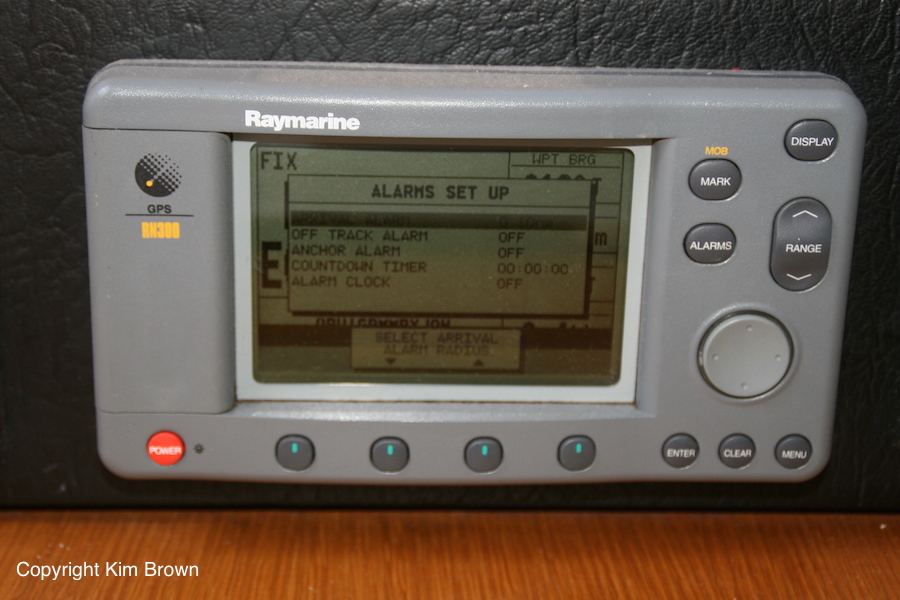
Unbelievably, I found it on one of our 14 computer display units. We have so many things to look at! Right on the front of a navigation station unit, I noticed a button that was labeled, ‘Alarms.’ I hit the button and it allowed me to set an alarm for track and the anchor. I thought, “OMG – all this time it was right in front of me.” (I forgive you if you’re thinking, ‘This girl really doesn’t have a clue – does she?!”)
Since finding the anchor alarm, we’ve never gone a night without using it.
So, to date, those are my anchoring stories. I’m sure I’ll have more. But what have I learned? What tips can I offer? What wisdom have I gleaned so early in our travels?
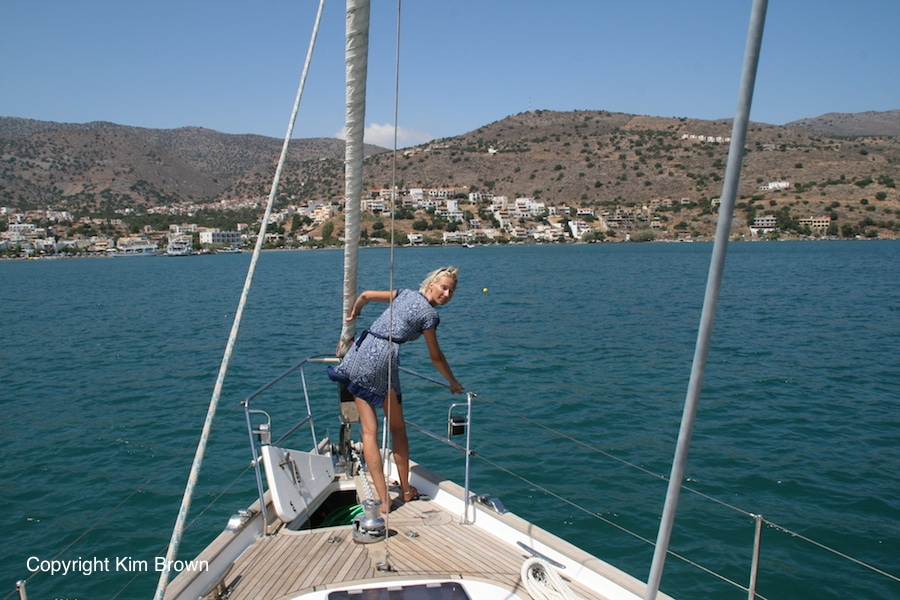
The Sailing Britican Guide on How to Anchor a Sailboat
Since writing this article my husband and I went on to anchor over and over again. We learned what to do and not do. The result?! I created an easy to digest Boat Basics: How to Anchor guide. I can’t promise that the guide will 100% prevent you from dragging but I can assure you that it will allow you to follow the right steps to anchoring properly. Avoid getting laughed at when entering a bay. Grab a copy of this guide now…
Other Relevant Articles on How to Anchor a Sailboat
Click here to check out all our Sailing, Manouvering & Mooring articles and videos and:
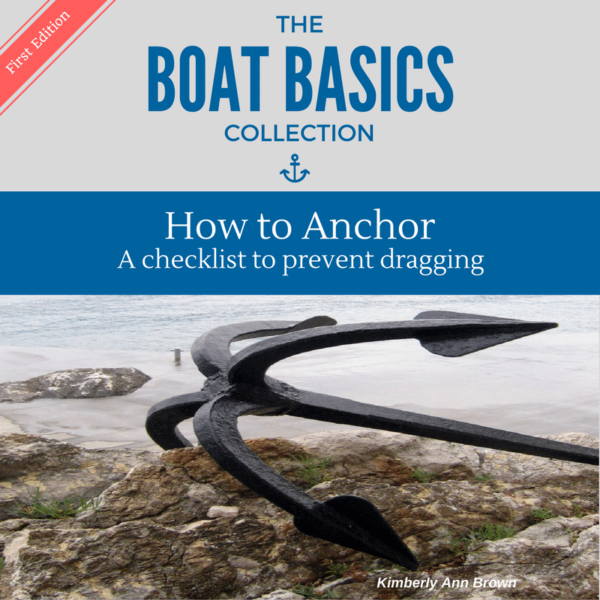
I must say that I am somewhat taken aback that people with designs on sailing the world did not take the time to understand the fundamentals of something as basic and important as anchoring. I am glad you were able to learn all about it without disastrous consequences and I respect you for being forthright in revealing your shortcomings but I hope you will now take the time to review other skills and equipment that you have heretofore dismissed.
Have you tried steering your boat with the emergency tiller? Or just by using the sails? have you shortened sail while hove to? …Just to name a few.
Good luck on your journey and please continue to learn those basic skills and knowledge.
Capt Rob Chichester, I must say that I do say things a bit tongue in cheek. I probably make out that I’m more naive than I am, but we all have to learn, experience and live to tell the tale. When anchored in a bay I witness all sorts of people (often from charters) that fail to understand that the anchor actually has to hit the ocean bottom! If you’ve read my blog you’ll see the vast amount of training courses I’ve taken – First aid, first aid for boaters, advanced first aid, diesel engines, comp crew, day skipper, VHF, 2-years practice on our boat in England and on and on and on. It might seem strange to you that someone without a massive sailing past would have designs on sailing the world but if we all had to learn the 1000’s of fundamentals we’d never go anywhere or do anything. Every day I’m tasked with learning another fundament. And if I tried to learn all the fundamentals I would have never set sail in the first place. Based on my observation, loads of people have issues about anchoring. I’m hoping my article helps them feel less intimidated about it…and all the fundamentals they have to learn…and then actually learn something. Perhaps you could write a guest blog or list for me and anyone reading my blog as to what the bare necessities are for sailing?! I certainly don’t know…I”m living by the seat of my pants and trying to do the best I can.
Good morning Kim…at least it is here on the East Coast of the US…
I am sorry if I read your post too literally. Absent any indications to the contrary, I tend to read things literally.
As a nearly lifelong sailor and a licensed mariner, one of my pet peeves is the apparent lack of knowledge and preparation on the part of boaters with whom I cross wakes. Reading your post (literally) touched that nerve. I apologize if my comment was overly strident.
Your question about how much preparation one needs before setting off on an adventure such as yours is an interesting question. (Could this be another blog post for you???) I would think basic seamanship skills and total familiarity with one’s vessel are things to be acquired before departure. However I must qualify my comments in that I have no desire to embark on an adventure such as yours. You would make a far better source on that topic and I wager that your opinions on that will be TOTALLY different at the conclusion of your travels than they were at the beginning.
As I plan to charter in Greece in September of 2015, I am about to read your posts about sailing there.
Fair winds to you all.
Good morning from Crete Capt Rob. I agree with you that there is a massive lack of knowledge and preparation on the part of boaters. I could write reams on all the incredibly ignorant things I’ve seen boaters (motor and sail) do.
While in Cowes, Isle of White, I actually saw a guy with a brand new gin palace, approach the jetty, jump off and then tie his warps on without pulling them tight. As the boat started to drift away, my husband ran over and explained the necessity of pulling them in to secure the boat to the side of the jetty.
That being said, aren’t we all ignorant about various things from time to time (hopefully not that ignorant!)? It’s not like we can get a boat, put it in a pool and wrap everything in bubble wrap.
We purchased our boat in Palma and had 24 hours to get out of the EU (for tax reason). We hired a professional skipper to help us to Gibraltar and learned how to unfortunately sail in a Force 10 amongst many other things. From Gib to Malta we hired another skipper to learn as much as we could about our new boat…getting stormbound in Algeria was an interesting experience! After Malta, however, we were on our own.
For the most part, I think we’re very safe and do things logically…but often we’re faced with situations that we didn’t know existed. For example, the first time we tied onto a mooring buoy I did my best to look at everyone else and follow suit. I didn’t get it right the first time, but now I know how to do it.
What am I saying?
Well, I think that no matter what, the world is going to be full of novice inexperienced boaters – there is often no way to get experienced other than trial and error. I believe that most people are doing the best they can and would love to be perfect, but that’s not how we learn.
Sailing non-stop now for over 5 months I’ve met loads of very experienced sailors. Every one of them has a tale of absolute failure – several have run aground, sunk their boats or had serious collisions with other objects. The experienced world cruising couple moored next to us right now told me a story about how they cracked their last boat in half by sailing it in conditions above and beyond what the boat could handle!
So…how much preparation does one need before he or she takes to the helm?
Yes, basic seamanship is good. Familiarity of one’s vessel – I suppose that’s something that comes with time. We’re learning something new about our boat every day. And after meeting several other world cruisers, they’ve explained that you never stop learning… I don’t think there is an answer to this.
Fortunately, wherever we go there have been loads of other sailors eager to help us out and we’ve repaid many other new sailors in turn. Just 2 weeks ago, an Italian gentleman and his wife attempted to tie onto a mooring buoy. After their 9th failed attempt, and previous offers from my husband to help, the captain finally gave the nod that it was time for assistance. My husband drove our dinghy over, explained to the captain to approach the buoy going into the wind and hubby fed the warps through the buoy and back onto the boat. Afterwards, the captain gave hubby a beer and offered sincere gratitude. My husband was also able to explain how we’ve tied onto a mooring buoy successfully. Heck, I give the couple credit – to try and fail so many times with an audience takes a lot of courage and determination.
So…to end this massive monologue, I totally agree with you. There are a lot of moron boaters out there – me being one of them! I can’t respond on behalf of all the other morons, but with absolute sincerity, I promise you Capt Rob I am learning as fast as I can to gain as much knowledge as I can.
I wish you a brilliant time on your charter in 2015 and fair winds to you too! Big smiles, Kim
Hi Kim
We use our anchor alarm, but we always set it at about 0.25nm if possible. The swing of a big boat easily hits that mark, and as long you have made the right allowance for other boats around this is fine – otherwise that alarm just goes off every time the boat moves!
One more thing we always do (and it depends upon your electronics I think) is we also Start a Track when we anchor. That way we can see how the boat is moving (usually in a nice semi circle). If it starts to move in a different direction we can see this straight away. If the wind changes in the night and the anchor alarm goes off, we can see immediately what has caused the alarm to go off- whether it is just the boat changing its heading or the boat drifting. You can also do this by putting a Waypoint on where the boat anchors (once it has settled of course because it will always move back a fair bit!). This at least gives you some indication of what is actually going on, and much easier than lining up with items on the shore, or other boats which might also be making their own way off their spot!
That is the only way that we can sleep at night too!
The idea about the Track is brilliant! Thank you for that… We’re getting gusts of 45 – 50 knots now in the bay we’re in (Sardinia). I have the alarm on – I always set it very low and increase it after it goes off. Making it go off allows me to know it’s working. We usually have to set ours to around the .3 mark – sometimes I up it to .4… Now I’ll turn the track on 🙂
Hi Kim
Sorry Kim, mistake in my typing, we set the alarm to anything between 25m and 40m, depending on conditions and people surrounding us!
Happy Sailing!
Vivienne
Hi Kim
Sorry Kim, mistake in my typing, we set the alarm to anything between 25m and 40m, depending on conditions and people surrounding us!
Just out of interest, what kind of anchor do you have?
Happy Sailing!
Vivienne
Kim,
I’m anchored right next to you here at Portisco. A couple of anchoring pointers from someone who sits on the hook in an Oyster 6 months per year. Never dump the chain out onto itself in one spot, it has a tendency to tangle with the anchor before the anchor digs in. Second, drop the anchor until it hits bottom, then reverse or allow the wind to back the boat as you let out the chain, it doesn’t need to be in a strait line, just the best you can. At 2:1 scope watch the anchor dig in if possible. Let out 5:1 scope or appropriate for the anchorage and depth. Set your snubber, or in my case, set the super snubber to take the strain off the windlass. Slowly increase engine revs over a 2-3 minute period all the way up to nearly full throttle. Then drop back to reverse idle and allow the boat to drift forward in a straight line. Set the anchor alarm.
Ken
That’s great information Ken. For the most part we’re doing that now… We tend to drop 3x and then pull back and then from 2x more…but you’re method of going back while dropping makes more sense. Thank you for this addition 🙂
I forgot two more important things to do when anchoring. A free dive visual check daily is critical along with pulling back using almost full throttle following a wind shift, especially if expecting high winds at the new angle.
Ken
Loved your article. I’m a fair weather, coastal sailor, and have never dropped anchor. Except for one night in Avalon Harbor, all my travels are marina to marina, with a secure dock to tie up to.
Am preparing to take some advanced courses and do some overnight excursions in the San Juans, which will require anchoring. I found your article both amusing, informative, and educational. Thanks for taking the time to write it.
And thank you for the feedback John! For the first couple years of my sailing life we never anchored (on our Moody 35 in the UK)! Interestingly, however, we had a bilge keel so we could have just let the tide flow out…(we never did). It took me a good year to feel confident about anchoring on Britican. When most time is spent at anchor a sailor has to make peace with the process. And of course, having an anchor alarm helps too! Thank you so much for your comments 🙂
Greetngs Kim,
I found your experinces very valuable. As someone just entering the cruising world, I certainly have the same trepidations about anchoring. So am am approaching this very similar to yourself. I’ve taken a fair amount of seamanship courses but now time for the real thing. Here in New England where I will sail from, most slips and moorings are hard to come by. Many are on a first-come, first-serve basis. Some harbors can tend to resemble a pack of roaming sharks looking for that one scrap of meat. Not exactly relaxing. So anchoring become a very good alternative….especially when you become comfortable enough to actually sleep! So I find your perspective very real and enlightening. Next big item will be my first open water overnight sail!
Cheers,
Harry
Safe anchoring is so important and necessary, thanks for sharing your experience here. Waiting for your new articles.
You haven’t mentioned long-lines to the shore ? A great way of helping the anchor hold and removing the risk of swinging into another boat. Used a lot in the Ionian. We use a floating line and swim it ashore, saves blowing up the dinghy….
Good point James. Yes – we used ropes to shore all around Greece. I’ll have to add that in. Thank you. Kim